
Photo: MRCC Mumbai
In our post yesterday we described the MOL Comfort as having “sunk.” That was in error. The ship did indeed break in two, but both halves are still afloat, at least according to recent photographs.


Photo: MRCC Mumbai
In our post yesterday we described the MOL Comfort as having “sunk.” That was in error. The ship did indeed break in two, but both halves are still afloat, at least according to recent photographs.
UPDATE: Contrary to initial reports that the ship sank, the two halves of the MOL Comfort have remained afloat. Tugs have been dispatched to the site.

PTI Photo
The container ship MOL Comfort sank today off Yemen after suffering catastrophic hull cracking near amidships. A Coast Guard official was quoted as saying, “The vessel hull broke into two off the Mumbai coast and the crew members were rescued from the ship in two life rafts and a life boat,” a Coast Guard official said. The ship was loaded with 4,500 containers was bound from Singapore to Jeddah. [Updated]
While there has been no determination why the ship’s hull broke, it seems likely that misloaded cargo might be the culprit. When loading a container ship, there is always an imbalance between the weight of the ship and cargo pressing down and the buoyancy of the sea pushing up. Too much weight in the ends can break a ship in half, which is what appears to have happened here.
Merchant vessel ‘Mol Comfort’ splits into two off Mumbai coast, crew rescued

From the I Fucking Love Science Facebook page.
 For more than 80 years, there has been an urban legend about congregations of alligators living in the depths of New York City sewers. (Yes,a group of alligators is called a “congregation.” I didn’t know that either until I looked it up.) The legend goes that baby alligators acquired in Florida or Louisiana, brought back to New York by vacationers were flushed down toilets in New York City and went on to live and breed in the city sewers. It never happened. City sewers turn out to not be a good habitat for alligators.
For more than 80 years, there has been an urban legend about congregations of alligators living in the depths of New York City sewers. (Yes,a group of alligators is called a “congregation.” I didn’t know that either until I looked it up.) The legend goes that baby alligators acquired in Florida or Louisiana, brought back to New York by vacationers were flushed down toilets in New York City and went on to live and breed in the city sewers. It never happened. City sewers turn out to not be a good habitat for alligators.
Now, however, not that far from the big city, on the western end of Long Island, there have been sightings of five alligators in the Peconinc River. So far, four have been captured while the fifth is still at large. Alligators are not native to New York State. They would be incapable of surviving the winter. Nevertheless, thsi is not the first sightin gof alligators on Long Island. Just last October, animal control officers trapped another five in another area of Long Island. As reported by Fox News:
 Congratulations to Francis Joyon, who set a new west to east singlehanded transaltantic sailing record. He sailed from New York’s Ambrose Light of and crossed the line linking Lizard Point, Cornwall to Ushant in a remarkable 5 days 2:56 minutes and 10 seconds, beating the previous record set by Thomas Coville in 2008 by 16 hours 34 minutes and 30 seconds.
Congratulations to Francis Joyon, who set a new west to east singlehanded transaltantic sailing record. He sailed from New York’s Ambrose Light of and crossed the line linking Lizard Point, Cornwall to Ushant in a remarkable 5 days 2:56 minutes and 10 seconds, beating the previous record set by Thomas Coville in 2008 by 16 hours 34 minutes and 30 seconds.
Joyan sailed a Groupe IDEC 29.7 meter trimaran and covered a distance over the bottom of 3,222 miles at an average speed of 26.20 knots. An amazing performance. Francis Joyon, 57, is a French professional sail boat racer and yachtsman, and currently also holds the record for the fastest single-handed sailing circumnavigation.
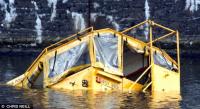 An amphibious tourist bus sank in Liverpool’s Albert Dock today. All 31 aboard the Yellow Duckmarine tour boat were rescued and no serious injuries were reported. Seventeen passengers were admitted to the hospital but have since been discharged. The youngest passenger was only 2 years old. This is the second sinking Yellow Duckmarine tour boat in the last three months. The previous sinking, in March, was of a tour boat without passengers aboard. Last May, Queen Elizabeth and Prince Philip took a ride on the Yellow Duck during a visit to Merseyside Maritime Museum.
An amphibious tourist bus sank in Liverpool’s Albert Dock today. All 31 aboard the Yellow Duckmarine tour boat were rescued and no serious injuries were reported. Seventeen passengers were admitted to the hospital but have since been discharged. The youngest passenger was only 2 years old. This is the second sinking Yellow Duckmarine tour boat in the last three months. The previous sinking, in March, was of a tour boat without passengers aboard. Last May, Queen Elizabeth and Prince Philip took a ride on the Yellow Duck during a visit to Merseyside Maritime Museum.
 In 1929, a portion of a world map was discovered in the archives at the Topkapı Palace in Istanbul. The map showed Europe, parts of Africa and Columbus’ discoveries in the New World. It was drawn in 1513 only 21 years after the voyages of Columbus, by Piri Reis, an Ottoman admiral and cartographer. Last Thursday, a reception was held to celebrate the 500th anniversary of the Piri Reis map at the International Maritime Organisation (IMO) Headquarters in London. A new 59 tile reproduction of the famous map was installed on a wall at IMO Headquarters to commemorate the anniversary.
In 1929, a portion of a world map was discovered in the archives at the Topkapı Palace in Istanbul. The map showed Europe, parts of Africa and Columbus’ discoveries in the New World. It was drawn in 1513 only 21 years after the voyages of Columbus, by Piri Reis, an Ottoman admiral and cartographer. Last Thursday, a reception was held to celebrate the 500th anniversary of the Piri Reis map at the International Maritime Organisation (IMO) Headquarters in London. A new 59 tile reproduction of the famous map was installed on a wall at IMO Headquarters to commemorate the anniversary.
The map is not only an important historical artifact but has also been the subject of speculation involving lost civilizations and even space aliens.
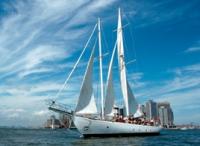
Schooner Shearwater
Father’s Day is celebrated in the United States on Sunday, June 16th. Here are a few selected Father’s Day sails which most salty dads are likely to enjoy:
New York Harbor – Schooner Shearwater, Father’s Day weekend – “Fathers will be offered drinks unlimited beer & wine for the duration of the sail. – “Shearwater Loves You Dad!”
New York Harbor – Clipper City Craft Beer Tasting Sails – Set sail on New York’s largest sailing vessel with the craft beer experts from Urban Oyster, and get introduced to the wonderful new world of Craft Beer.
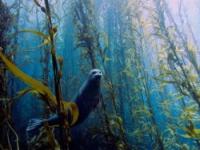
Best Overall Photo 2013 University of Miami Underwater Photo Contest: Harbor seal in kelp forest photographed by Kyle McBurnie.
From more than 650 underwater images submitted, Kyle McBurnie’s photo of a harbor seal in a kelp forest at Cortes Bank was chosen as “Best Overall” photograph in the the 2013 Annual Underwater Photography Contest hosted by the University of Miami (UM) Rosenstiel School of Marine & Atmospheric Science. Click here to view the winning photographs in all categories. Thanks to Irwin Bryan for passing along the news.
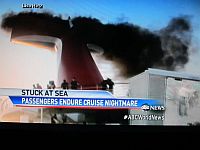 What a difference a blackout and overflowing toilets can make. In September of last year the headline in the L.A. Times was “Cruise industry rebounding from ship accident, woes in Europe.” The subtitle read, “Cruise reservations seem to be rising, with the drop in European bookings offset by strong U.S. sales. The Costa Concordia disaster had only a short-term effect.”
What a difference a blackout and overflowing toilets can make. In September of last year the headline in the L.A. Times was “Cruise industry rebounding from ship accident, woes in Europe.” The subtitle read, “Cruise reservations seem to be rising, with the drop in European bookings offset by strong U.S. sales. The Costa Concordia disaster had only a short-term effect.”
Then came the fire on the Carnival Triumph in February which left the ship in the Gulf of Mexico without power, running water, hot food lighting or air conditioning. Unlike the tragedy on the Costa Concordia, where 32 passengers and crew died, no one died or was seriously injured. Nevertheless, the proximity to US media markets guaranteed that the stories of toilets overflowing and sewage in the hallways would get full coverage on the networks, newspapers and across the internet.
A Harris poll released this week shows trust in the cruise industry in general and Carnival in particular has plummeted since the incident. Since the fire on the Carnival Triumph, America’s trust in cruise lines has dropped by 12%. For Carnival, the news is much worse. Trust in the world’s largest cruise conglomerate has fallen by 26% in the same period.

Photo: RICHARD A. BROOKS/AFP/GETTY IMAGES
Thousands thronged Hong Kong’s Victoria harbor waterfront to say goodbye to a beloved four-story inflatable yellow duck. (See our recent post, Spreading Joy Around the World,” aka “Rubber Duck” – Inflated, Deflated, Revived & Censored) The huge inflatable duck, which is named “Spreading Joy Around the World,” is the creation of the Dutch artist Florentijn Hofman. It has has lived up to its name, having visited Sydney, Japan, France, Sao Paolo, Amsterdam and Hong Kong. It’s next stop is reported to be Pittsburgh for the four-week International Festival of Firsts that begins late September. Thanks to Phil Leon for passing the news along.
Hong Kong waves bye-bye to beloved 4-story rubber ducky after month-long splash

Photo: ru.wikipedia.org/Wofratz/cc-by-sa 3.0
A group of 16 Russian scientists, monitoring climate change in the Arctic, encountered more than they had planned on. They had to be rescued when the ice beneath their station began to crack due to unusually warm weather. The Russian nuclear icebreaker Yamal reached the research station, off Canada, on Saturday, eight days after departing Murmansk. The crew of the icebreaker is expected to collect the SP-40 research station’s remaining equipment within the next four or five days. Thanks to Dave Shirlaw on the MARHST-L for pointing out the article.
Russian atomic icebreaker rescues scientists from cracked ice floe in Arctic
 The news stories are depressingly familiar. A ferry, often in a developing nation, sinks along the coast or in a river and the lives of hundred are lost. In regions where ferries are the most necessary, they are often the most dangerous. Safe and affordable ferries are desperately needed. The World Ferry Safety Association is sponsoring a competition to design such a ferry. Student teams from six maritime universities are competing in the Safe Affordable Ferry Design Competition to develop a ferry design for a 500 passenger ferry for Bangladesh.
The news stories are depressingly familiar. A ferry, often in a developing nation, sinks along the coast or in a river and the lives of hundred are lost. In regions where ferries are the most necessary, they are often the most dangerous. Safe and affordable ferries are desperately needed. The World Ferry Safety Association is sponsoring a competition to design such a ferry. Student teams from six maritime universities are competing in the Safe Affordable Ferry Design Competition to develop a ferry design for a 500 passenger ferry for Bangladesh.
The student teams competing are from (in alphabetic order), Istanbul Technical University, Maine Maritime Academy, National Technical University of Athens, Tolani Maritime Institute, India, University of Applied Sciences in Bremen, University of British Columbia, and Webb Institute in New York. A panel of six judges (see below) will review the submissions and will announce the winners by early Fall 2013. The top prize is $5,000 with second and third prizes also to be awarded.
Yesterday, we posted about a report by the WWF on shipping accident “hotspots” around the world. The report noted that often these regions of increased risk of ship sinking or collision also coincided with environmentally sensitive areas. Fortunately the shipping industry is beginning to focus on protecting areas of the oceans which are particularly sensitive to damage by ships. The International Maritime Organization (IMO) has an ongoing program to designate Particularly Sensitive Sea Areas (PSSA) which need special protection because of their “significance for recognized ecological or socio-economic or scientific reasons and which may be vulnerable to damage by international maritime activities.”
Here is a PSA (Public Service Announcement) about IMO’s PSSAs.
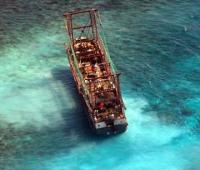
Chinese Fishing Vessel Aground on Tubbataha reef
Happy World Oceans Day! The World Wildlife Federation has released a study to coincide with World Oceans Day, documenting dangerous “hotspots” around the globe for accidents involving ships. Sadly many of these “hotspots” also coincide with some of the most ecologically important ocean regions. The South China Sea and East Indies, east Mediterranean and Black Sea, North Sea and British Isles were found to be particularity at risk for for accidents involving ships.
South China Sea, Mediterranean and North Sea are shipping accidents hotspots
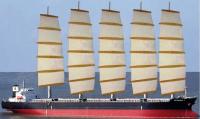 For those near New York harbor next Monday, I will be giving a presentation on “The Future of Commercial Sail” at the monthly New York City Shiplore meeting on Monday, June 10th at 7:30 PM at 79 Walker Street, 5th floor, in Manhattan.
For those near New York harbor next Monday, I will be giving a presentation on “The Future of Commercial Sail” at the monthly New York City Shiplore meeting on Monday, June 10th at 7:30 PM at 79 Walker Street, 5th floor, in Manhattan.
Oil prices are four times higher today than they were just a decade ago. Wind power is the fastest growing sector in the energy business. Is it time for a return to wind power to propel modern commercial ships?
In Monday’s presentation, we will be looking at what made the windjammers of the late 19th and early 20th centuries uneconomical, and the impact of current energy prices and new environmental rules on shipping; and will ask whether these economics might justify a return to commercial sail. We will also look at a variety of new designs of sailing ships being developed by a new generation of naval architects. It should be fun evening. If you are the neighborhood, stop by.
McBook Press‘ wonderful publication Quarterdeck, has a fascinating interview with Joan Druett in their June 2013 edition. We are reposting it here with permission.
 Award-winning author Joan Druett sailed back into nautical fiction in 2005 with the launch of A Watery Grave, introducing the Wiki Coffin Mysteries, which are set against the U.S. Exploring Expedition in 1838. By this time, Druett was already an established author, writing maritime history, as well as fiction. Druett, who lives and writes in New Zealand, launches her Promise of Gold Trilogy this month. It will be digitally published by Old Salt Press, with trade paperback editions following.
Award-winning author Joan Druett sailed back into nautical fiction in 2005 with the launch of A Watery Grave, introducing the Wiki Coffin Mysteries, which are set against the U.S. Exploring Expedition in 1838. By this time, Druett was already an established author, writing maritime history, as well as fiction. Druett, who lives and writes in New Zealand, launches her Promise of Gold Trilogy this month. It will be digitally published by Old Salt Press, with trade paperback editions following.
Quarterdeck recently interviewed the author just as she was about the head out to sea:
How did you arrive at writing as your vocation? And, what initially drew you to the sea and nautical nonfiction as subject matter for your books?

Senator with “Pirate” Eyepatch
I was under the impression that the State of Michigan had serious problems – a $2 billion budget shortfall, its largest city in dire economic straits, schools closing for lack of funding, that sort of thing. Things must be better than I realized as Sen. Roger Kahn (R-Saginaw) proposed and the Senate passed a resolution officially recognizing “International Talk Like a Pirate Day”. If they have time for this sort of resolution in the Senate, things must not be as bad as I thought. One can only hope that the eye patch that Senator Kahn wore while presenting the resolution is not also his proposal for ophthalmic heath care.
The resolution itself notes that “International Talk Like A Pirate Day” was started “as a way to express [the event founder’s] individual passion for nautical plundering.” The resolution goes on to say that the State of Michigan is responsible for “promoting worthy maritime initiatives” and that “Talk Like a Pirate Day” “celebrates beloved maritime activities.” Linking “nautical plundering” with “worthy maritime initiatives” and “beloved maritime activities” all in one very short resolution is just dumb. Really dumb.
One event that the State of Michigan did not choose to endorse is the IMO International Day of the Seafarer held on June 25 of each year to recognize “the invaluable contribution seafarers make to international trade and the world economy, often at great personal cost to themselves and their families.” Apparently the Michigan Senate prefers pirates.

Photo:PHILIPPE LOPEZ / AFP / GETTY IMAGES
In early May, a five story high inflatable rubber duck was set adrift in Hong Kong harbor. The duck was sponsored by the Harbour City shopping mall. Created by the Dutch artist Florentijn Hofman, it was named “Spreading Joy Around the World” but is universally known simply as “Rubber Duck.” The duck is well traveled. Since 2007, it has visited 13 cities in nine different countries. Arriving in Hong Kong, it was an immediate hit. As reported by the New York Times:
Thousands gathered around the waterfront when “Rubber Duck” made its debut May 2. Since then, countless duck-themed products have shown up at shops and restaurants. Teenagers are wearing rubber-duck outfits, and tourist kiosks are selling rubber-duck postcards. Its smiling face was even seen at the Cheung Chau bun festival, a 200-year-old tradition on an outlying island.
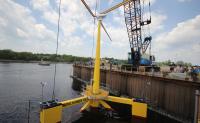
Photo: Jeff Kirlin
Typically, modern offshore wind turbines come in only one size and shape – really big, rising up from the ocean floor. The University of Maine, with support from the Department of Energy, has just launched a new test design, the first grid-connected floating wind tower. The tower, launched in Brewer, Me., is supported by three hollow concrete tube floats and will be anchored in the Gulf of Maine. VolturnUS 1:8, which sounds like something from a bad science fiction novel, is only 20 kw in capacity but, should it succeed, the design should be scalable up to much larger installations. Using a floating rather than a fixed platform would allow wind turbines to be installed in much deeper water on the West Coast of the US and along the Maine Coast.